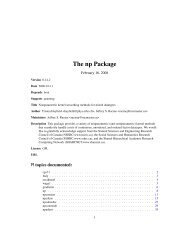The mvpart Package - NexTag Supports Open Source Initiatives
The mvpart Package - NexTag Supports Open Source Initiatives
The mvpart Package - NexTag Supports Open Source Initiatives
You also want an ePaper? Increase the reach of your titles
YUMPU automatically turns print PDFs into web optimized ePapers that Google loves.
4 cmds.diss<br />
Arguments<br />
data<br />
k<br />
x.use<br />
zero.chk<br />
plt<br />
plot.subset<br />
plot.subn<br />
Data matrix<br />
Number of vectors to be returned<br />
Use extended dissimilarity?<br />
Check for zero row sums – if zero ignore these rows according to method<br />
Plot the relationship between the dissimilarities and the distances calculated<br />
from the scaled output vectors.<br />
Plot a subset of the points – useful for large data sets.<br />
Controls how many points are plotted when plot.subset=TRUE. <strong>The</strong> number<br />
of points plotted is 750 + N * plot.subn where N = number of rows in data.<br />
... arguments passed to either xdiss or gdist<br />
Details<br />
<strong>The</strong> function knows the same dissimilarity indices as gdist. Plotting the relationship between<br />
the dissimilarities and the distances calculated from the scaled output vectors is useful in assessing<br />
potential loss of information. If the loss is high then the results from partitioning directly from the<br />
dissimilarity matrix using distance-base partitioning (see dist in rpart),and those obtained from<br />
partitioning the output of cmds.diss using multivariate regression trees (see mrt in rpart) can be<br />
substantial.<br />
Author(s)<br />
Glenn De’ath<br />
Examples<br />
data(spider)<br />
dist.vecs

















